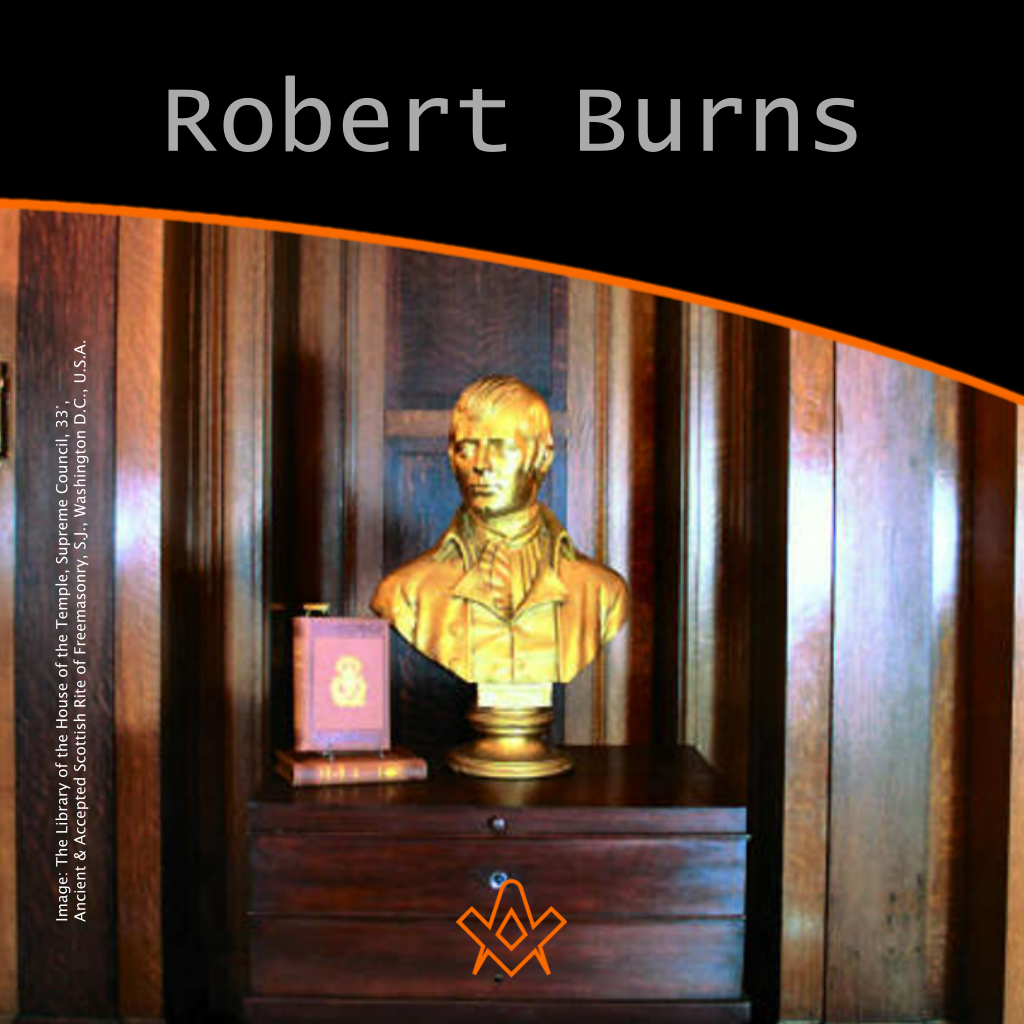The twenty-fifth of January each year, is a very important date for Scots throughout the world, being the birth date of our national bard Robert Burns, the Ayrshire lad, who despite his short time on earth left a literary body of work which has stood the test of time; and will do so, for as long as people enjoy the beauty of the written word and the joy it can engender.
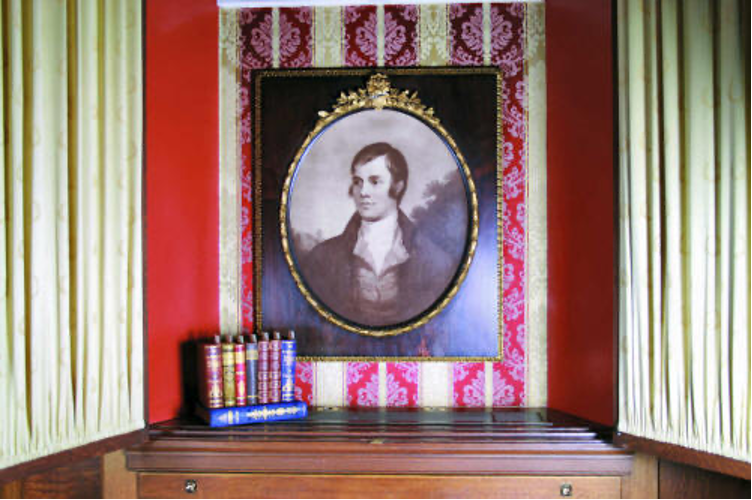
IMAGE CREDIT: The Library of the House of the Temple, Supreme Council, 33°, Ancient & Accepted Scottish Rite of Freemasonry, S.J., Washington D.C., U.S.A.
Because he was a member of the Craft, we Freemasons can claim him all over again and take great pride in the fact that such a talented man was one of us, and that in his work he inculcated many of the Masonic principles learned in the Lodge room.
In order for his work to continue to be enjoyed, we are indebted to those, for whom a love of his work led to their collecting the many books and pamphlets, both by and about Burns, often referred to as Burnsiana.
One to whom we are deeply indebted is William Robertson Smith, a fellow Scot, who like many before and since, left his native land during the 19th century and made his way across the Atlantic, to the brave new world of America.
He took the love of his native land and its national bard with him though, and amassed a collection which is now held within the Robert Burns Library, at the Library of the Supreme Council of the Ancient & Accepted Scottish Rite, Southern Jurisdiction, Washington DC, USA.
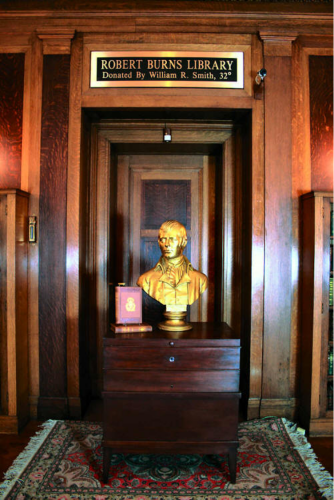
IMAGE CREDIT: The Library of the House of the Temple, Supreme Council, 33°, Ancient & Accepted Scottish Rite of Freemasonry, S.J., Washington D.C., U.S.A.
The William Robertson Smith Collection houses one of the largest and most significant collections of literary works of Robert Burns, and Burnsiana in the world.
There are larger collections elsewhere, not least in the Bard’s home country of Scotland, and other significant collections repose in the Mitchell Library in Glasgow, Scotland; and the G. Ross Roy Collection at the University of South Carolina in the United States of America.
Notwithstanding, the Smith collection is very significant in its own right, and as William Robertson Smith was a Scottish Rite Freemason, it is particularly fitting that his collection is contained within the House of the Temple of the Ancient and Accepted Scottish Rite of Freemasonry in Washington D.C.
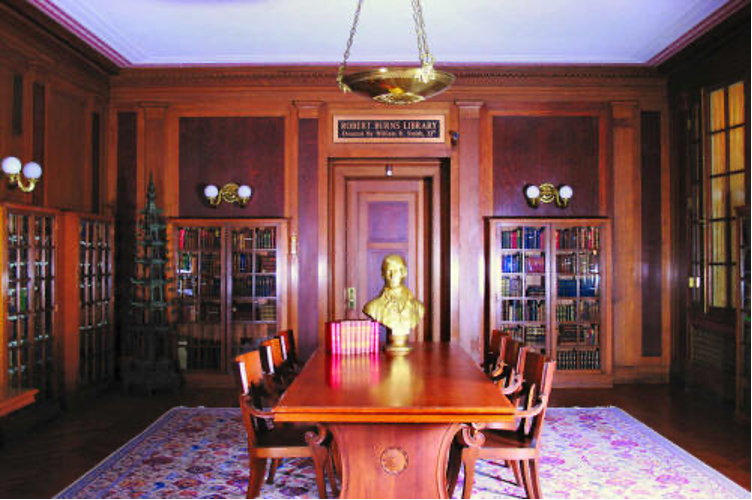
IMAGE CREDIT: The Library of the House of the Temple, Supreme Council, 33°, Ancient & Accepted Scottish Rite of Freemasonry, S.J., Washington D.C., U.S.A.
A catalogue of the collection was published in 2008 with the assistance of a benefactor of the library, and the Smith Collection now formally takes its rightful place as one of the most important collections of Burnsiana in the world today.
The collection was catalogued by Larissa P. Watkins, Assistant to the Librarian at the House of the Temple, and is entitled:
BURNSIANA: A BIBLIOGRAPHY OF THE WILLIAM R. SMITH COLLECTION IN THE LIBRARY OF THE SUPREME COUNCIL, 33°, S.J.
As then Grand Master Mason of Washington DC, Akram Elias stated at that time:
The 250th anniversary of the birth of Robert Burns in 2009 will doubtless be as ‘an international beacon of Scotland’s cultural life…, [and] international icon for Scotland’s creative and literary tradition’.
As such, it affords a unique rationale and opportunity to present the catalogue of the House of the Temple Library’s important Burnsiana Collection to a large and interested readership.
A literary achievement of this magnitude with its connection to Freemasonry brings international attention and notice to the House of the Temple Library.
It also elevates the authority of the Supreme Council, Southern Jurisdiction, the Mother Council of the World, as an organisation which asserts principles and ideas rooted in the universal historical and cultural inheritance of all civilisations of the world.
In light of the fact that Robert Burns was a Brother and Masonic Poet associated with the celebrated Lodge Canongate Kilwinning, and that William Robertson Smith was also a Masonic brother and 32nd degree Scottish Rite Mason, this catalogue acquires even more meaning as a living memorial to international Masonic fraternal and literary traditions.
The collection is accessible to scholars, historians, literary critics, linguists, and students specialising in this field from throughout the world.
In 2009, the International Conference on the History of Freemasonry (ICHF) returned to Edinburgh, Scotland, and as befitted the time and location, a number of papers were presented on subjects relating to Robert Burns; and the authors of some of those papers relied heavily on the utility of the Smith Collection.
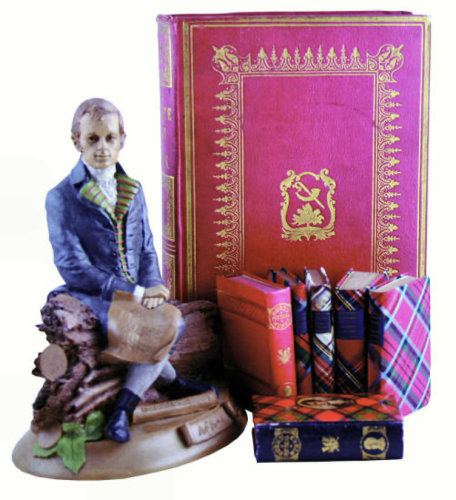
IMAGE CREDIT: The Library of the House of the Temple, Supreme Council, 33°, Ancient & Accepted Scottish Rite of Freemasonry, S.J., Washington D.C., U.S.A.
Each of these scholars drew from the extensive works, by and about Burns, contained within the Smith Collection during the course of their research, and owed a debt of gratitude to the man who created the collection, as will those who will undoubtedly follow in their footsteps in years to come.
Dr Valentina Bold, a Burns scholar from the University of Glasgow has visited the Smith Collection and told this writer:
The Burns Collection within the Scottish Rite Temple in Washington DC is a wonderful, and shamefully underused, collection of publications by, and relating to, Burns. Larissa P. Watkins recently completed the catalogue, under the general editorship of Akram Elias, and this will undoubtedly redress the balance, encouraging wider use among the scholarly community in the USA and beyond.
As well as a rich selection of American editions of Burns, particularly those from Philadelphia, Boston and New York, there are most of the key British editions, including the Edinburgh and London.
There are also the major texts of Burns criticism one would expect in a collection amassed by a private, and knowledgeable collector, alongside supporting texts relating to Scottish cultural life and, in particular, poetry.
In addition, there are clippings relating to Burns’ life and the commemoration of that life; copies of materials relating to Burns celebrations; and quirky additional items, like a set of unusual chapbooks, some from little-known publishers.
In short, this is a treasure trove of Burnsiana, and one that deserves to be used regularly and certainly alongside better known collections, such as the G. Ross Roy collection of Burnsiana and Scottish Literature, at the University of South Carolina.
The reach of Burns poetry is truly global, and schoolchildren throughout the world recite his lines quite readily.
This is due in no small part to the fact his poems are entertaining, but also speak of universal truths and aspirations, such as brotherly love and freedom.
When considering Burns’ great enthusiasm for Freemasonry, author Marie Roberts writes:
There were a number of attractions for him: first the fellowship of the lodge served a convivial role at a time when social clubs proliferated.
Secondly, Freemasonry with its revolutionary connections would have appealed to Burns’ radicalism.
The Masonic ideals of liberty, equality, and fraternity united his support of the French revolution with his Scottish patriotism.
These ideals which so attracted Burns to Freemasonry likewise attracted the founding fathers of America, and even the first President of that nation Brother George Washington is said to have subscribed to the second American edition of the poetry of Burns during his tenure as Master of Alexandria Lodge No. 22.
Brother Elias stated that Burns’ poem, The Ode for General Washington’s Birthday:
…Created an environment of inspiration for artist Max Rosenthal; who fashioned the graphic depiction of this event on canvas.
There are no Masonic signs or symbols, but there is something that captures the spirit and philosophy of the fraternity, the canvas exudes an air of harmony and agreement and a dignified deference to the accomplishments of age and a prudent understanding of the passions of youth.
In this work, the artist visually conveys the ideas written in the tenets of the Order: Master Masons meet upon the level, act by the plumb, and part upon the square.
The painting depicts a seated Washington looking up at and listening intently to Burns, who is standing, delivering one of his poems to the great American leader and Freemason.
Who then was William Robertson Smith, the man to whom the people of America and the world are indebted for helping keep the ‘immortal memory’ of Robert Burns alive?
William Robertson Smith was born on 21 March 1828, at Athelstaneford, East Lothian, Scotland; the son of William Smith and Agnes Robertson.
During his early years in Scotland he worked as a gardener, at one time working for the Duke of Atholl on his estate in North Perthshire.
He spent his last two years in Britain working at the Royal Kew Gardens before emigrating to the United States of America.
Working in the open air must have done him the power of good, as he grew to be a giant of a man, standing at a height of six feet three inches.
He eventually became Superintendent at the Botanic Gardens in Washington DC in 1854, remaining there until 1912.
During this period, the works of Burns were very popular in America, particularly among the Masonic fraternity, and his fame had spread throughout that continent.
Smith was an avid collector of Burnsiana, and it was during this period that he gathered his collection which eventually grew into the large and important library that it is today.
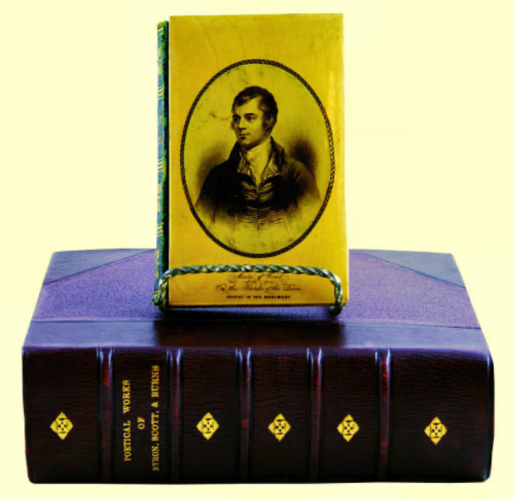
IMAGE CREDIT: The Library of the House of the Temple, Supreme Council, 33°, Ancient & Accepted Scottish Rite of Freemasonry, S.J., Washington D.C., U.S.A.
Smith was a good friend of Scottish Industrialist and noted philanthropist Andrew Carnegie, and the multi-millionaire used his financial clout to assist his friend Smith in acquiring many rare and expensive books.
Smith died on 7 July 1912, and for the last 16 years of his life, he was tended by his housekeeper Mrs Jackson, who helped make his final days comfortable.
A newspaper of the day reported on the occasion when an interested party called at Smith’s home, keen to take a look at the collection:
Well, you see, I promised him that I’d not let anybody at all glimpse these books until Mr Carnegie comes to take charge of them.
But, I guess t’wouldn’t hurt if you got just a peep at them’, and slowly turning the key, one follows her into the room with a feeling almost of entering a sepulchre.
Almost reverentially, she touches certain volumes, and with hushed voice tells the individual history and value of each.
‘Ah!’ she says a little regretfully, and with a tinge of pride even so, ‘the very biggest people of Washington have come here and sat with Mister Smith and talked with him about Burns, and there didn’t any of them know half as much about him as he did.
He just worshipped anything that had to do with Burns, and when he had that last sickness, when he was upstairs in his own bed, and couldn’t come down here among these books he loved, there was always somebody coming who’d get just the book he wanted out of them all, and sit up there beside his bed reading Burns to him by the hour.
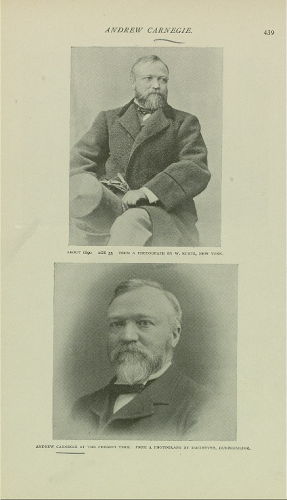
Andrew Carnegie
IMAGE CREDIT: The New York Public Library Digital Collections
Smith himself once said of Robert Burns:
I believe with Lord Morley, that Burns did more for democracy in its broadest sense than any other mortal, and I believe that he did still more for religion. Family worship, the daily kneeling at the family altar, has been the greatest thing that ever came to Scotland.
Andrew Carnegie was amongst a host of names who were on the board of trustees of Smith’s proud collection. The board declared:
It will be necessary for the board to meet before any disposition can be made of the books, as Mister Smith left no provision for their disposal. But, inasmuch as his whole life was spent in Washington, and above all cities, he preferred the capital; the probabilities are the collection will remain there.
With regards to this, and the fact Smith, like his hero Burns was an ardent Freemason; there can be little doubt that Smith would have been very satisfied with the final repose of his beloved collection.
Article by: Kenneth C. Jack
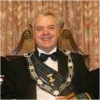
Kenneth C. Jack FPS is an enthusiastic Masonic researcher/writer from Highland Perthshire in Scotland.
He is Past Master of a Craft Lodge, Past First Principal of a Royal Arch Chapter, Past Most-Wise Sovereign of a Sovereign Chapter of Princes Rose Croix.
He has been extensively published in various Masonic periodicals throughout the world including: The Ashlar, The Square, The Scottish Rite Journal, Masonic Magazine, Philalethes Journal, and the annual transactions of various Masonic bodies.
Kenneth is a Fellow of the Philalethes Society, a highly prestigious Masonic research body based in the USA.


The Masonic Genius of Robert Burns: An Address Delivered in Lodge “Quatuor Coronati,” 2076, 4th March, 1892
By: Benjamin Ward Richardson
Social history as a corrective to a historiography is often too limited to diplomacy and wars.
It began an upward trajectory as early as the 1930s, but it remains constrained by the frustrating cost and availability of materials that even great research libraries lack.
This volume is a case in point. Fraternal movements like Freemasonry have impacted society for hundreds of years. Yet, over time research into their undoubted influence has been handicapped by their codes of secrecy, arcane rituals, and the paucity of continuing tertiary research projects.
As a step towards “more light” Westphalia Press has produced a number of scarce titles that will be helpful in understanding the “secret empire” of lodges, initiations, and (candidly) the deliberately inscrutable.
Robert Burns was coronated the Poet Laureate of Freemasonry in a Scottish lodge ceremony and his Masonic odes are still today recited with gusto in lodge rooms.
This new edition is dedicated to Robert Cooper, Grand Librarian of the Grand Lodge of Scotland, and helpmate to many scholars.

Robert Burns, Poet-Laureate of Lodge Canongate Kilwinning
By: Hugh C. Peacock
Excerpt from Robert Burns, Poet-Laureate of Lodge Canongate Kilwinning: Facts Substantiating His Election and Inauguration on 1st March 1787; Gleaned From the Lodge Records and Other Authentic Sources
Burns as t/ze last Poet Laureate of t/ze Lodge. Nay, some of them, Sir Charles Hope – were alive in 1845, when the Lodge resolved to commemorate the event by a Picture.
All this is on record, nor is it contested that the tradition has been handed down continuously to the present time.
Recent Articles: Kenneth C. Jack
 Observations on the History of Masonic Research Archaeology is often associated with uncovering ancient tombs and fossilized remains, but it goes beyond that. In a Masonic context, archaeology can be used to study and analyze the material culture of Freemasonry, providing insight into its history and development. This article will explore the emergence and evolution of Masonic research, shedding light on the challenges faced by this ancient society in the modern world. |
 Anthony O'Neal Haye – Freemason, Poet, Author and Magus Discover the untold story of Anthony O’Neal Haye, a revered Scottish Freemason and Poet Laureate of Lodge Canongate Kilwinning No. 2 in Edinburgh. Beyond his Masonic achievements, Haye was a prolific author, delving deep into the history of the Knights Templar and leaving an indelible mark on Scottish Freemasonry. Dive into the life of a man who, despite his humble beginnings, rose to prominence in both Masonic and literary circles, leaving a legacy that continues to inspire. |
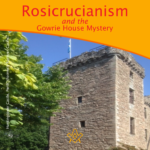 Rosicrucianism and the Gowrie House Mystery Unearth the mystifying intersections of Rosicrucianism and the infamous Gowrie House Mystery. Dive into speculative claims of sacred knowledge, royal theft, and a Masonic conspiracy, harking back to a fateful day in 1600. As we delve into this enthralling enigma, we challenge everything you thought you knew about this historical thriller. A paper by Kenneth Jack |
 Thomas Telford's Masonic Bridge of Dunkeld Of course, there is no such thing as a ‘Masonic Bridge’; but if any bridge is deserving of such an epithet, then the Bridge of Dunkeld is surely it. Designed by Scotsman Thomas Telford, one of the most famous Freemasons in history. |
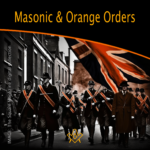 The masonic and orange orders: fraternal twins or public misperception? “Who’s the Mason in the black?” |
 Kenneth Jack's research reveals James Murray, 2nd Duke of Atholl – the 'lost Grand Master' |
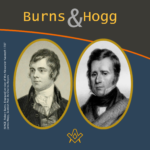 An Oration delivered to the Annual Burns and Hogg Festival, at Lodge Canongate Kilwinning, No. 2, Edinburgh, on 24 January 2018. By Bro. Kenneth C. Jack, FSAScot FPS, Past Master, Lodge St. Andrew, No. 814, Pitlochry. |
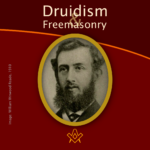 William Winwood Reade was a Scottish philosopher, historian, anthropologist, and explorer born in Crieff, Perthshire, Scotland. The following article by Kenneth Jack, provides some hints that William may have been a Freemason, but there is presently no definitive evidence he was. |
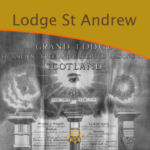 What's in a name? A brief history of the first Scottish Lodge in Australia - By Brother Kenneth C. Jack, Past Master, Lodge St. Andrew, No. 814, Pitlochry |
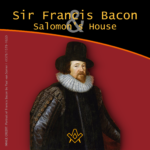 Sir Francis Bacon and Salomon’s House Does Sir Francis Bacon's book "The New Atlantis" indicate that he was a Rosicrucian, and most likely a Freemason too? Article by Kenneth Jack |
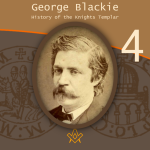 George Blackie – The History of the Knights Templar P.4 The final part in the serialisation of George Blackie's 'History of the Knights Templar and the Sublime Teachings of the Order' transcribed by Kenneth Jack. |
 George Blackie – The History of the Knights Templar P.3 Third part in the serialisation of George Blackie's 'History of the Knights Templar and the Sublime Teachings of the Order' transcribed by Kenneth Jack. |
 George Blackie – The History of the Knights Templar P.2 Second part in the serialisation of George Blackie's 'History of the Knights Templar and the Sublime Teachings of the Order' transcribed by Kenneth Jack. |
 George Blackie – The History of the Knights Templar P.1 First part in the serialisation of George Blackie's History of the Knights Templar and the Sublime Teachings of the Order – by Kenneth Jack |
 Little known as a Freemason, Bro Dr Robert ‘The Bulldog’ Irvine remains a Scottish rugby legend, and his feat of appearing in 10 consecutive international matches against England has only been surpassed once in 140 years by Sandy Carmichael. |
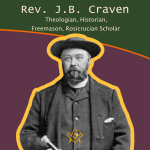 Rev. J.B. Craven: Theologian, Historian, Freemason, And Rosicrucian Scholar Archdeacon James Brown Craven is one of those unsung heroes of Scottish Freemasonry about whom very little has been previously written – here Kenneth Jack explores the life and works of this remarkable esoteric Christian. |
 Discover the powerful family of William Schaw, known as the 'Father of Freemasonry' |
 This month, Kenneth Jack invites us to look at the life of Sir William Peck; - astronomer, Freemason and inventor of the world's first electric car. A truly fascinating life story. |
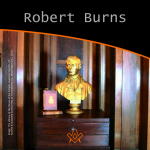 A Tribute to Scotland's Bard – The William Robertson Smith Collection With Burns' Night approaching, we pay tribute to Scotland's most famous Bard – The William Robertson Smith Collection |
 The Joy of Masonic Book Collecting Book purchasing and collecting is a great joy in its own right, but when a little extra something reveals itself on purchase; particularly with regards to older, rarer titles.. |
 Masons, Magus', and Monks of St Giles - who were the Birrell family of Scottish Freemasonry? |
 The 6th Duke of Atholl - Chieftain, Grand Master, and a Memorial to Remember In 1865, why did over 500 Scottish Freemasons climb a hill in Perthshire carrying working tools, corn, oil and wine? Author Kenneth Jack retraces their steps, and reveals all. |
 Charles Mackay: Freemason, Journalist, Writer Kenneth Jack looks at life of Bro Charles Mackay: Freemason, Journalist, Writer, Poet; and Author of ‘Tubal Cain’. |
 A Mother Lodge and a Connection Uncovered, a claim that Sir Robert Moray was the first speculative Freemason to be initiated on English soil. |
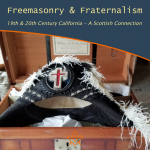 What is it that connects a very old, well-known Crieff family, with a former President of the United States of America? |
 The life of Bro. Cattanach, a theosophist occultist and Scottish Freemason |
 The Mysterious Walled Garden of Edzell Castle Explore the mysterious walled garden steeped in Freemasonry, Rosicrucianism, and Hermeticism. |
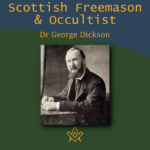 Dr. George Dickson: Scottish Freemason and Occultist Bro. Kenneth explores the life of Dr George Dickson a Scottish Freemason and Occultist |
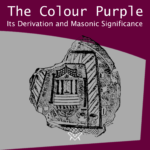 The Colour Purple - Its Derivation and Masonic Significance What is the colour purple with regards to Freemasonry? The colour is certainly significant within the Royal Arch series of degrees being emblematical of Union. |
 Bridging the Mainstream and the Fringe Edward MacBean bridging mainstream Freemasonry with the fringe esoteric branches of Freemasonry |
 Freemasonry in the Works of John Steinbeck We examine Freemasonry in the Works of John Steinbeck |
 Renegade Scottish Freemason - John Crombie Who was John Crombie and why was he a 'renegade'? |
 Scottish Witchcraft And The Third Degree How is Witchcraft connected to the Scottish Third Degree |
masonic knowledge
to be a better citizen of the world
share the square with two brothers

click image to open email app on mobile device


